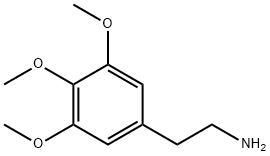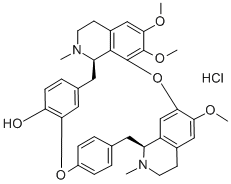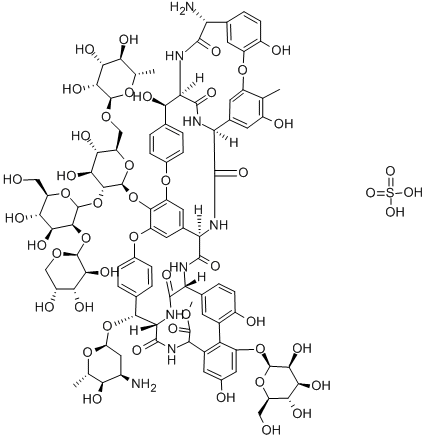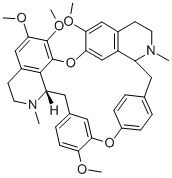3,4,5-TRIMETHOXYPHENETHYLAMINE, HYDROCHLORIDE
- CAS NO.:54-04-6
- Empirical Formula: C11H17NO3
- Molecular Weight: 211.26
- EINECS: 200-190-7
- SAFETY DATA SHEET (SDS)
- Update Date: 2023-05-09 09:30:27

What is 3,4,5-TRIMETHOXYPHENETHYLAMINE, HYDROCHLORIDE?
Description
Mescaline is one of the main active ingredients in the peyote plant, Lophophora williamsii. It is also found in several other cacti including the South American Trichocereus otherwise known as the Peruvian torch species. Mescaline can also be synthesized in the laboratory. It is one of the oldest known hallucinogenic drugs. Ingestion of mescaline via use of the peyote cactus has been used in rituals by North American Indians dating back thousands of years. Ingestion of peyote was also common among the Aztec, Apache, and Pima Indians for religious, ceremonial, and medicinal purposes. Mescaline was isolated from peyote in 1896 by the chemist Hefter and in 1919, the chemical structure was confirmed by Spath. There are many analogs of mescaline with over 250 being prepared and self-tested by the chemist and pharmacologist, Alexander Shulgin (aka Sasha Shulgin). Mescaline became a Schedule I drug and was placed in Controlled Substances Act in 1970. Many of the related chemicals or analogs of mescaline were also placed in Schedule I of the Controlled Substances Act.
Chemical properties
White Powder
The Uses of 3,4,5-TRIMETHOXYPHENETHYLAMINE, HYDROCHLORIDE
Psychedelic Alkoloid
The Uses of 3,4,5-TRIMETHOXYPHENETHYLAMINE, HYDROCHLORIDE
Mescaline is used recreationally as a hallucinogenic drug and it is used in religious ceremonies for spiritual purposes by groups such as the Native American church. Mescaline is purported not to have any therapeutic benefits based on its Schedule I status. When used recreationally typical doses range from 300 to 500 mg orally.
Definition
ChEBI: A phenethylamine alkaloid that is phenethylamine substituted at positions 3, 4 and 5 by methoxy groups.
Hazard
Highly toxic by ingestion.
Safety Profile
Poison by intraperitoneal and intravenous routes. Moderately toxic by ingestion route. An experimental teratogen. Other experimental reproductive effects. Human systemic effects by intramuscular route: euphoria and hallucinations, dstorted perceptions. A psychotoimetic agent (a drug of abuse). When heated to decomposition it emits toxic fumes of NOx.
Environmental Fate
The primary exposure pathway is oral via ingestion of the chemical powder or salt or via ingestion of peyote ‘ buttons.’ These buttons are the round, fleshy tops of the cactus that are sliced and dried. Multiple buttons of peyote are typically ingested due to the relatively small content (i.e., 40–50 mg) of individual peyote buttons.
Toxicity evaluation
The exact mechanism of mescaline has not been clearly defined. The central nervous system effects of mescaline appear to involve stimulation of both serotonin and dopamine receptors. In experimental studies, these effects can be blocked by either serotonin antagonists such as methysergide or dopamine antagonists such as haloperidol. Mescaline is structurally related to the amphetamines and cathine and cathinone, which are found in the plant Catha edulis. Mescaline is a ring-substituted phenethylamine. Sympathomimetic effects can occur and are thought to be centrally mediated. High doses of peyote/mescaline can produce more pronounced sympathomimetic effects such as tachycardia and hypertension. Hallucinations may be associated with homicidal, suicidal, or psychotic behaviors. There have been no reported deaths due to the physiological effects of peyote/mescaline. Traumatic deaths have occurred secondary to hallucinations. Mescaline does not appear to inhibit monoamine oxidase.
Properties of 3,4,5-TRIMETHOXYPHENETHYLAMINE, HYDROCHLORIDE
| Melting point: | 35-36° |
| Boiling point: | bp12 180° |
| Density | 1.1240 (rough estimate) |
| refractive index | 1.5718 (estimate) |
| pka | 9.57±0.10(Predicted) |
| CAS DataBase Reference | 54-04-6 |
Safety information for 3,4,5-TRIMETHOXYPHENETHYLAMINE, HYDROCHLORIDE
Computed Descriptors for 3,4,5-TRIMETHOXYPHENETHYLAMINE, HYDROCHLORIDE
New Products
4,4-Difluoropiperidine hydrochloride tert-butyl 9-methoxy-3-azaspiro[5.5]undecane-3-carboxylate Indole Methyl Resin N-Isopropylurea N,N-Dicyclohexylcarbodiimide(DCC) MELDRUMS ACID 5-METHYLISOXAZOLE-4-CARBOXYLIC ACID Magnessium Bis glycinate Zinc ascorbate 1-bromo-2-butyne 2-acetamidophenol 9(10H)-anthracenone Erythrosin B, 4-Piperidinopiperidine 2-((4-morpholinophenylamino) (methylthio) methylene) malononitrile 2,4-dihydroxybenzaldehyde 3-(4-morpholinophenylamino)-5-amino-1H-pyrazole-4-carbonitrile Methyl 2-methylquinoline-6-carboxylate 2,6-dichloro-4-nitropyridine 4-Bromo-2-chlorobenzonitrile 2-(benzylamino)acetic acid hydrochloride 4-(tert-Butoxycarbonylamino)but- 2-ynoic acid 3,4-dihydro-2H-benzo[b][1,4]dioxepine 1-Phenyl-1-cycloprppanecarboxylicacidRelated products of tetrahydrofuran








You may like
-
 3-(4-amino-1-oxoisoindolin-2-yl)-1-methylpiperidine-2,6-dione 98%View Details
3-(4-amino-1-oxoisoindolin-2-yl)-1-methylpiperidine-2,6-dione 98%View Details -
 1-methylindoline-2,3-dione 98%View Details
1-methylindoline-2,3-dione 98%View Details
2058-74-4 -
 614-19-7 98%View Details
614-19-7 98%View Details
614-19-7 -
 3112-85-4 Methyl phenyl sulfone 98%View Details
3112-85-4 Methyl phenyl sulfone 98%View Details
3112-85-4 -
 20677-73-0 (2,2-diethoxyethyl)methylamine 98%View Details
20677-73-0 (2,2-diethoxyethyl)methylamine 98%View Details
20677-73-0 -
 3-(4-(hydroxyamino)-1-oxoisoindolin-2-yl)piperidine-2,6-dione 98%View Details
3-(4-(hydroxyamino)-1-oxoisoindolin-2-yl)piperidine-2,6-dione 98%View Details -
 57381-49-4 2-bromo-4-chlorobenzonitrile 98%View Details
57381-49-4 2-bromo-4-chlorobenzonitrile 98%View Details
57381-49-4 -
 4,6-dichloropyrimidine-5-carbaldehyde 98%View Details
4,6-dichloropyrimidine-5-carbaldehyde 98%View Details
5305-40-8
